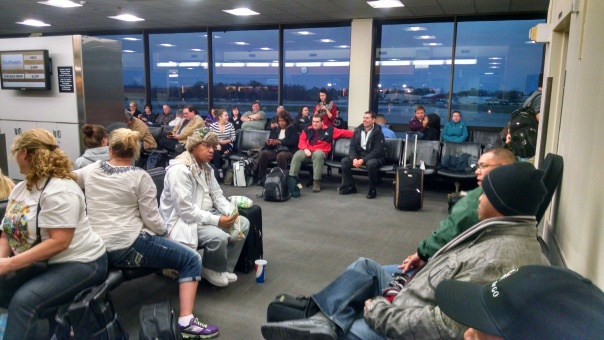Let me start with an apology to DonorDreams readers for my recent absence. My workload has increased exponentially lately, and the last few mornings when I’ve sat down to write the floodgates opened unexpectedly. I will try harder, but if things don’t get better, then I will have to seek out more guest bloggers and re-publish popular posts from the past. Please accept my apologies and my promise to work this problem. ~Erik
This morning’s post is top of mind because I’ve recently had the privilege of working with a non-profit organization that is encountering a cash flow situation. First, let me say that this is something many non-profit leaders have had to deal with. Second, I’ve recently come to realize that many people freeze when confronted with these situations and very little is written about how to survive such a crisis. So, I’m going to provide a few tips from my experiences of working with clients facing a cash flow and payroll crisis.
Ask board members to contribute
 The people closest to your mission are board and staff members. So, when the organization is short on cash and cannot meet its payroll obligations, it is only natural to ask board members to dig a little deeper.
The people closest to your mission are board and staff members. So, when the organization is short on cash and cannot meet its payroll obligations, it is only natural to ask board members to dig a little deeper.
While this will bring in some money and help bridge the gap (at least partially), the bigger reason you need to start with the board is that no other donor will jump into the gap if they don’t see the board doing their fair share. Additionally, you won’t likely be able to get board members to jump in and help you engage other donors if it doesn’t feel like they have skin in the game.
Ask key donors to contribute
 Don’t pass the basket and ask smaller, low capacity donors. Identify your larger, more capable donors and schedule an in-person meeting to explain what has occurred and ask for their support.
Don’t pass the basket and ask smaller, low capacity donors. Identify your larger, more capable donors and schedule an in-person meeting to explain what has occurred and ask for their support.
Be careful!
Don’t make your “case for support” sound like your organization is the S.S. Titantic. You might get a contribution from someone by telling them you’ll go out of business without their support, but making the ask that way makes getting future gifts significantly more difficult.
Why?
Because no one likes to through good money after bad money. Remember . . . only the captain goes down with the ship.
So, when talking to those key donors, make sure to explain what happened and why you’re in this situation. Clearly explain to them what the plan is for getting out of the hole. Make sure to keep your message mission-focused because donors are emotionally attached to your clients and programs. They are not inspired by your overhead and business challenges.
Contact your accounts receivable list
 Accounts receivable can be any number of the following individuals/entities:
Accounts receivable can be any number of the following individuals/entities:
- individual donors with pledges that are due at a later date
- foundations or government agencies who have given you a grant and your reimbursement paperwork is still pending
- individuals or companies you invoiced for a service you provided and are still waiting for payment
Call these people and explain your situation. Ask them if they could work with you on paying their pledge early, speeding up the reimbursement paperwork, or paying their outstanding invoice sooner-rather-than-later.
Always keep in mind that you catch more flies with honey than you do vinegar. Being polite is a necessity because your crisis isn’t their problem. More importantly, you are in the relationship building business, and your words today can impact your relationships tomorrow.
Pay your bills carefully
 If your organization finds itself in this mess, then the bank is probably not extending you additional credit. While managing your cash flow on the backs of your vendors is a bad thing to do, sometimes life presents you with a bunch of bad options.
If your organization finds itself in this mess, then the bank is probably not extending you additional credit. While managing your cash flow on the backs of your vendors is a bad thing to do, sometimes life presents you with a bunch of bad options.
Make sure to prioritize what little cash you have in the bank towards making payroll. The phone company can wait a few weeks. However, be transparent and ethical about this strategy. Pick-up the phone and call the vendors who will be impacted by this decision. Explain your situation and ask them for patience and assistance. You might be surprised at their response.
Don’t rest once the crisis passes
 This crisis came to your door for a reason, and you owe it to your clients, donors, volunteers and community to make sure it doesn’t happen again. The following is an incomplete checklist of things you should consider:
This crisis came to your door for a reason, and you owe it to your clients, donors, volunteers and community to make sure it doesn’t happen again. The following is an incomplete checklist of things you should consider:
- Revisit the budget and make necessary changes
- Create a cash flow project tool and keep it updated
- Invest in evaluating board composition, structure and governance practices and fill those gaps ASAP
- Evaluate executive leadership and make changes if necessary
- Conduct a resource development audit and use it as a springboard to create a written resource development plan
Has your organization ever experienced a cash flow crisis that resulted in a payroll panic? I know this can feel embarrassing, but please share your thoughts and experiences in the comment box below. We can all learn from each other, and our clients and communities can benefit from that collective wisdom.
Here’s to your health!
Erik Anderson
Founder & President, The Healthy Non-Profit LLC
www.thehealthynonprofit.com
erik@thehealthynonprofit.com
http://twitter.com/#!/eanderson847
http://www.facebook.com/eanderson847
http://www.linkedin.com/in/erikanderson847











